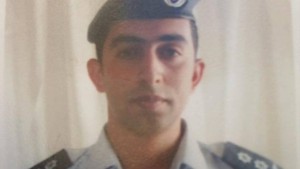Who was Jordanian pilot Moath al-Kasasbeh, killed by ISIS?
Royal Jordanian Air Force pilot Moath al-Kasasbeh cut a swashbuckling pose in one military photo, with hands akimbo on his hips, exuding confidence.In another, the cleanshaven young man in uniform appears deadly serious, as one might expect from a fighter pilot whose airstrikes demand precision.Behind his military postures was a devout Muslim who memorized the Quran and hailed from a large family and prominent tribe noted for its loyalty to the monarchy.
Al-Kasasbeh's fate had been a mystery since last December, when his aircraft crashed during a mission and he was reportedly captured by ISIS in Syria.That mystery ended Tuesday when video and images purportedly by ISIS show the pilot suffered a horrible death.Footage and images released by the Islamist militants depict the pilot in a cage, being burned alive.Jordanian state TV confirmed his death, but CNN could not immediately verify the authenticity of the tape.
"Modest and religious"
The pilot's father, Safi al-Kasasbeh, described his son as an unassuming Muslim. The father made those remarks well before his son's death was disclosed.

At the time of the capture, Safi al-Kasasbeh told the Jordan Times that his son was "a very modest and religious person," who memorized the Muslim holy book and "was never harmful to anyone."The 27-year-old pilot was a lieutenant, according to the Jordan Times, an English-language newspaper published daily in the kingdom.
One of eight children, Moath al-Kasasbeh came from Karak governorate in Jordan and graduated from King Hussein Air College, the newspaper said.Prior to the announcement of his death, a message purportedly from ISIS had presented an ultimatum to Jordan: Bring convicted terrorist Sajida al-Rishawi to the Turkish border by sunset January 29 or the pilot will die.Tied to his fate was that of Japanese hostage Kenji Goto, whoseapparent beheading was shown in a video released by ISIS militants over the weekend.Jordan had said it was ready to release al-Rishawi if al-Kasasbeh were to be released unharmed.Reeling with shock at how the pilot was murdered, Jordanian officials were said to be considering a military response to ISIS's claims.
King Abdullah condemned the killing, and said that "the brave pilot was killed in defense of his religion, his country and his (Islamic) nation.""It is the duty of the sons and daughters of Jordan to stand together and show the mettle of the Jordanian people in unity, determination and resolve," the King said.A Jordanian official said the pilot was actually killed a month ago, in early January.
'Precious' blood
The purported immolation is a macabre closure to al-Kasasbeh's life.While he was still considered missing, the family's desperation grew as time passed and as al-Kasasbeh's fate was linked to that of Goto and the release of al-Rishawi.Goto appeared to hold a picture of the pilot, now bearded, in a video message purported to be from ISIS that was released in January.On the same day, Safi al-Kasasbeh joined hundreds of fellow Jordanians at a solidarity protest held in the capital, Amman, where he called on the Jordanian authorities to act to secure his son's release.
"I firmly ask whomever has sent Moath to fight outside the borders of Jordan, on a mission unrelated to us, to make strong efforts to bring back Moath," he said."Moath's blood is precious. It's precious and it represents the blood of all Jordanians," he said.
The plight of Moath al-Kasasbeh resonated with King Abdullah, who has been a pillar of the international effort against ISIS and is himself a former helicopter pilot.The young captive hailed from a high-ranking tribe considered especially loyal to the royal family.Abdullah's wife, Queen Rania, posted an image to her 400,000 Instagram followers shortly after meeting with the pilot's family.
"We are all Moath," it said in Arabic, beneath a picture representing a fighter jet in the colors of the Jordanian flag.From the start, Jordan has played a pivotal part in the U.S.-led coalition against ISIS, but it was not a popular war within Jordan, which only added to the pressure on the authorities to secure al-Kasasbeh's release.
'They will kill me'
In late December, ISIS published in its English-language online magazine Dabiq what it claimed was an "interview" with the pilot.Al-Kasasbeh was shown wearing what appeared to be an orange jumpsuit.Asked whether he knew what ISIS would do with him, he replied: "Yes. They will kill me."The militants claimed they captured al-Kasasbeh after he ejected from the crashing of his F-16 on December 24. The pilot was part of the U.S.-led coalition airstrikes near ISIS' de-facto capital, Raqqa.
Images provided by ISIS's media wing and circulated widely on social media showed bearded men with Kalashnikovs pulling the terrified airman out of a nearby river."We entered the region of Raqqa to sweep the area, then the striker jets entered to begin their attack," al-Kasasbeh said, according to the online publication. "My plane was struck by a heat-seeking missile. I heard and felt its hit."The Jordanian government and U.S. Central Command said the aircraft had crashed but adamantly stated ISIS had not shot it down, as the group claims.
"I checked the system display and it indicated that the engine was damaged and burning," the pilot was quoted as saying. "The plane began to deviate from its normal flight path, so I ejected. I landed in the Furat River by parachute and the seat caught on some ground, keeping me fixed, until I was captured by soldiers of the Islamic State.
NewsCurtesy: www.cnn.com











